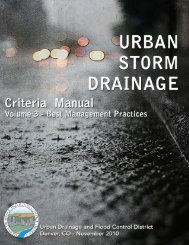Hydraulic Efficiency of Grate and Curb Inlets - Urban Drainage and ...
Hydraulic Efficiency of Grate and Curb Inlets - Urban Drainage and ...
Hydraulic Efficiency of Grate and Curb Inlets - Urban Drainage and ...
Create successful ePaper yourself
Turn your PDF publications into a flip-book with our unique Google optimized e-Paper software.
the model was <strong>of</strong>ten either lower or higher than the exact point <strong>of</strong> splash-over velocity for a<br />
given grate length. No efforts were made to directly measure splash-over velocity in this study.<br />
It was possible, however, to determine a theoretical splash-over velocity from the efficiency,<br />
velocity, <strong>and</strong> flow characteristics <strong>of</strong> each applicable test. The approach presented here is to<br />
back-calculate V o from the equations given previously in Sections 2.2.1 <strong>and</strong> 2.2.2. A unique<br />
value for V o can then be determined for a given inlet length from a regression <strong>of</strong> the results.<br />
When Equation 2-7 is solved for V o , the following form presented as Equation 5-1 results:<br />
( 1−<br />
R )<br />
⎡ f ⎤<br />
Vo = V − ⎢ ⎥<br />
Equation 5-1<br />
⎣ 0.<br />
09 ⎦<br />
where:<br />
V = velocity <strong>of</strong> flow at the inlet (ft/s) determined from Q/A;<br />
V o = splash-over velocity (ft/s); <strong>and</strong><br />
R f = ratio <strong>of</strong> frontal flow captured by the inlet to the total frontal flow.<br />
In Equation 5-1, the parameter R f must be less than or equal to one to determine a<br />
physically-meaningful splash-over velocity. When R f is greater than or equal to one, flow<br />
velocity is less than or equal to splash-over velocity <strong>and</strong> all frontal flow is captured by a grate.<br />
When R f is less than one, flow velocity is greater than splash-over velocity <strong>and</strong> splashing <strong>of</strong> some<br />
frontal flow over a grate occurs. As grate length increases, flow velocity must increase for water<br />
to splash completely over a grate. When Equation 2-10 is solved for R f , the following form<br />
presented as Equation 5-2 results:<br />
R<br />
f<br />
⎡<br />
E<br />
⎣<br />
⎛ Q<br />
R ⎜<br />
⎝<br />
⎞⎤<br />
⎟⎥ ⎠ ⎦<br />
Q<br />
s<br />
= ⎢ −<br />
s<br />
Equation 5-2<br />
Q Qw<br />
where:<br />
E = inlet capture efficiency;<br />
R s = ratio <strong>of</strong> side flow captured to total side flow;<br />
R f = ratio <strong>of</strong> frontal flow captured by the inlet to the total frontal flow;<br />
Q = volumetric flow rate (cfs);<br />
Q w = flow rate in the depressed section <strong>of</strong> the gutter (cfs); <strong>and</strong><br />
Q s = flow rate in the section above the depressed section (cfs).<br />
Parameters Q w , Q s , <strong>and</strong> R s were calculated directly from the geometry <strong>of</strong> the street <strong>and</strong><br />
gutter sections using the applicable equations presented previously in Sections 2.2.1 <strong>and</strong> 2.2.2.<br />
56
















